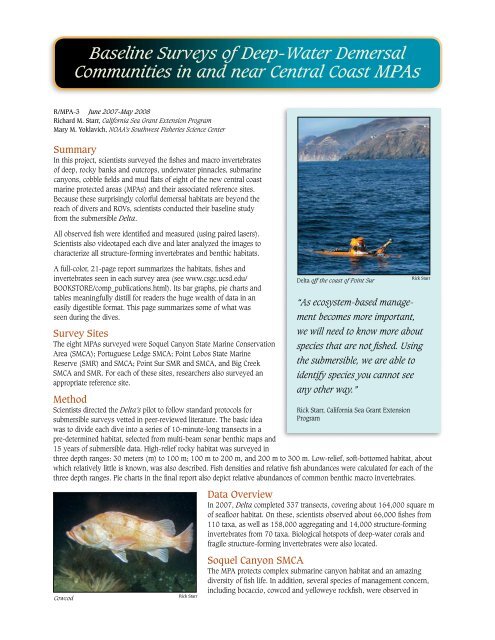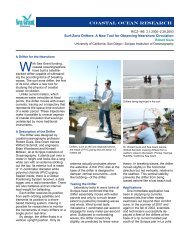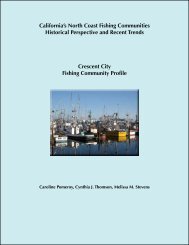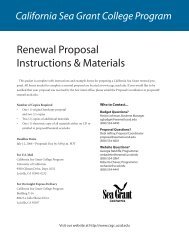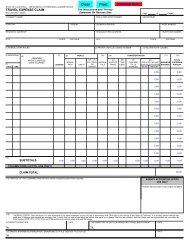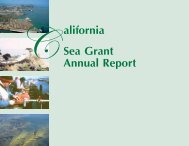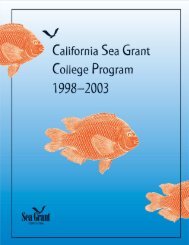California's Central Coast Marine Protected Areas - California Sea ...
California's Central Coast Marine Protected Areas - California Sea ...
California's Central Coast Marine Protected Areas - California Sea ...
Create successful ePaper yourself
Turn your PDF publications into a flip-book with our unique Google optimized e-Paper software.
Baseline Surveys of Deep-Water Demersal<br />
Communities in and near <strong>Central</strong> <strong>Coast</strong> MPAs<br />
R/MPA-3 June 2007-May 2008<br />
Richard M. Starr, <strong>California</strong> <strong>Sea</strong> Grant Extension Program<br />
Mary M. Yoklavich, NOAA’s Southwest Fisheries Science Center<br />
Summary<br />
In this project, scientists surveyed the fishes and macro invertebrates<br />
of deep, rocky banks and outcrops, underwater pinnacles, submarine<br />
canyons, cobble fields and mud flats of eight of the new central coast<br />
marine protected areas (MPAs) and their associated reference sites.<br />
Because these surprisingly colorful demersal habitats are beyond the<br />
reach of divers and ROVs, scientists conducted their baseline study<br />
from the submersible Delta.<br />
All observed fish were identified and measured (using paired lasers).<br />
Scientists also videotaped each dive and later analyzed the images to<br />
characterize all structure-forming invertebrates and benthic habitats.<br />
A full-color, 21-page report summarizes the habitats, fishes and<br />
invertebrates seen in each survey area (see www.csgc.ucsd.edu/<br />
BOOKSTORE/comp_publications.html). Its bar graphs, pie charts and<br />
tables meaningfully distill for readers the huge wealth of data in an<br />
easily digestible format. This page summarizes some of what was<br />
seen during the dives.<br />
Survey Sites<br />
The eight MPAs surveyed were Soquel Canyon State <strong>Marine</strong> Conservation<br />
Area (SMCA); Portuguese Ledge SMCA; Point Lobos State <strong>Marine</strong><br />
Reserve (SMR) and SMCA; Point Sur SMR and SMCA, and Big Creek<br />
SMCA and SMR. For each of these sites, researchers also surveyed an<br />
appropriate reference site.<br />
Method<br />
Scientists directed the Delta’s pilot to follow standard protocols for<br />
submersible surveys vetted in peer-reviewed literature. The basic idea<br />
was to divide each dive into a series of 10-minute-long transects in a<br />
pre-determined habitat, selected from multi-beam sonar benthic maps and<br />
15 years of submersible data. High-relief rocky habitat was surveyed in<br />
“As ecosystem-based manage-<br />
ment becomes more important,<br />
we will need to know more about<br />
species that are not fished. Using<br />
the submersible, we are able to<br />
identify species you cannot see<br />
any other way.”<br />
Rick Starr, <strong>California</strong> <strong>Sea</strong> Grant Extension<br />
Program<br />
three depth ranges: 30 meters (m) to 100 m; 100 m to 200 m, and 200 m to 300 m. Low-relief, soft-bottomed habitat, about<br />
which relatively little is known, was also described. Fish densities and relative fish abundances were calculated for each of the<br />
three depth ranges. Pie charts in the final report also depict relative abundances of common benthic macro invertebrates.<br />
Cowcod<br />
Rick Starr<br />
Delta off the coast of Point Sur<br />
Rick Starr<br />
Data Overview<br />
In 2007, Delta completed 337 transects, covering about 164,000 square m<br />
of seafloor habitat. On these, scientists observed about 66,000 fishes from<br />
110 taxa, as well as 158,000 aggregating and 14,000 structure-forming<br />
invertebrates from 70 taxa. Biological hotspots of deep-water corals and<br />
fragile structure-forming invertebrates were also located.<br />
Soquel Canyon SMCA<br />
The MPA protects complex submarine canyon habitat and an amazing<br />
diversity of fish life. In addition, several species of management concern,<br />
including bocaccio, cowcod and yelloweye rockfish, were observed in


